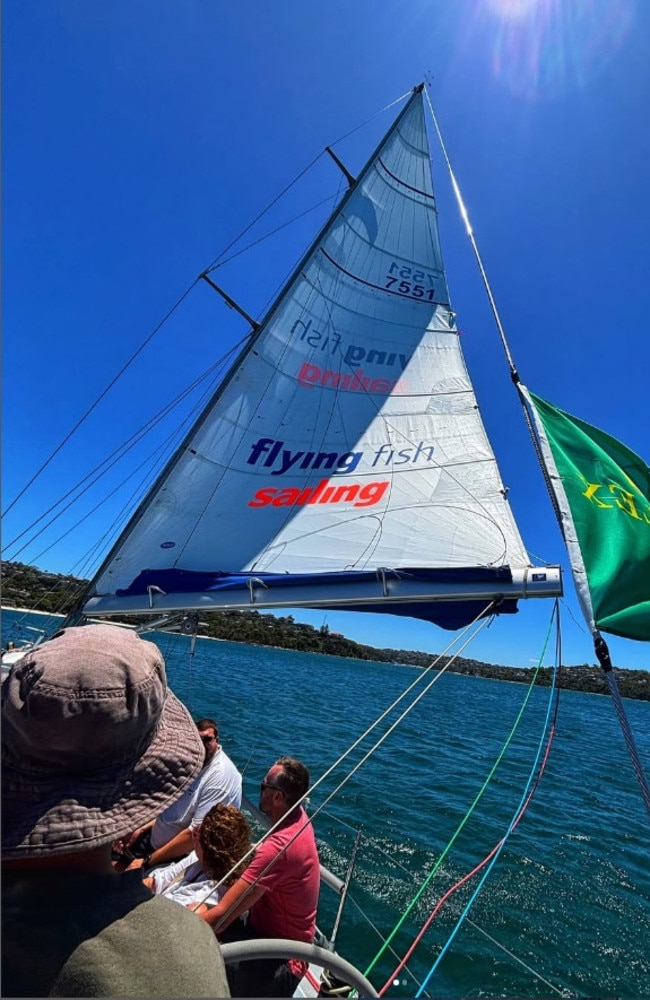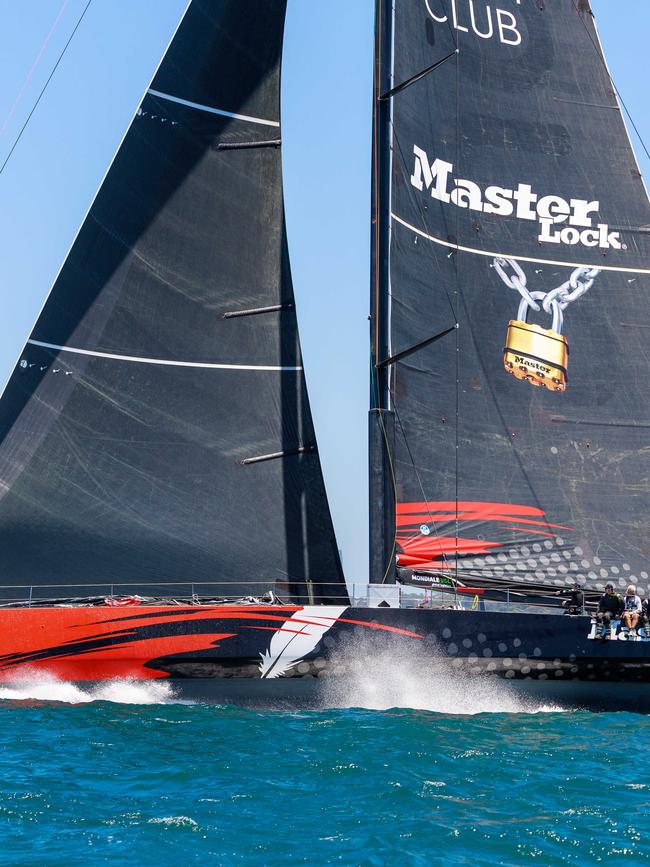Sailors in Sydney to Hobart tragedies identified
The two sailors who were killed at sea during the Sydney to Hobart race have been identified after it was revealed how they died.

Other Sports
Don't miss out on the headlines from Other Sports. Followed categories will be added to My News.
The two sailors killed in Friday morning’s Sydney to Hobart tragedy have been identified as Roy Quaden, 55, and Nick Smith, 65.
NSW Police provided an update on Friday afternoon from Batemans Bay — saying the two sailors died in separate incidents as the fleet of 104 vessels made its way down the NSW south coast.
In a night of devastation and destruction, wild, windy conditions rocked the fleet with 16 race retirements.
Both sailors died after being struck by a sail boom, according to the Sydney to Hobart race committee.
A boom is a large horizontal pole that extends from the bottom of a mast and can be adjusted towards the direction of the wind.
Mr Quaden was a member of the Flying Fish Arctos crew, while Mr Smith was aboard the yacht Bowline.


Superintendent Joe McNulty, commander in charge of Marine Area Command, shared what may have contributed to the shock deaths.
“Early investigations (suggest) that those vessels may have been changing sails at the time, so they weren’t actually sailing with the wind,” Spt McNulty said.
“That creates a whole different set of circumstances … so that may have contributed to the deaths.”
Mr Quaden was the navigator on the Flying Fish Arctos yacht, when just before midnight the boom reportedly swung out and hit him in the head.
Police were notified immediately as crew members aboard attempted CPR but were unable to revive him.
The boat was forced to sail for another eight hours back to Jervis Bay with Mr Quaden’s dead body aboard.

Hours later the second tragedy struck when Mr Smith, who was operating the ropes, was struck by the boom shortly before 3am (AEDT).
It was Mr Smith’s fourth time competing in the Sydney to Hobart race.
He was on board Bowline alongside Melanie Bushby, Reid Bosward, Paul “Banjo” Greaves, Paul Senior, Anthony Pennington, Troy Mohler and navigator Peter Hutchinson
An image of the crew was posted online last week by Mr Mohler showing the crew making the journey from Adelaide to Sydney before the race.
“2,000 kms done. We have arrived in Sydney,” he wrote.
“The last 48 hours were such a mixed bag, some beautiful sailing followed by 12 hours of full on wind, consistently 30 knots, up to 38.
“We’ve done almost two Sydney to Hobarts to get to the start line. Has been a blast.”

A statement from the skipper and owner of the yacht, SA barrister Ian Roberts, mourned the loss of a friend.
“Today we lost a great friend and a very fine and experienced yachtsman in an accident aboard Bowline whilst competing in this year’s Rolex Sydney Hobart Yacht Race,” the statement read.
“In very difficult sailing conditions, crew member Nick Smith was hit by main sheet in a gybe that threw him against a winch.
“Despite immediate CPR administered by the crew, Nick was unable to be resuscitated.
“Nick was a very valued crew member and a very experienced sailor. Having completed four previous Sydney Hobart’s, numerous yacht deliveries and the around the world ‘Clipper Race Yacht’ race. He was also a regular competitor in the Hamilton Island Sailing Regatta.
“Having sailed many thousand miles with Nick, the skipper and crew of Bowline are devastated with this loss.”

Mr Smith was a member of the Royal South Australian Yacht Squadron and had been since 2013.
In a statement, the sailing club said they were devastated by his death.
“On behalf of the Commodore, Flag Officer, Management Committee, members and staff we extend our condolences to Nick’s family, friends and the crew of Bowline at this tragic time,” they said.
“We express our sympathy to Bowline Skipper – Immediate Past Commodore Ian Roberts – and further extend our sympathy to Flying Fish Arctos and their crew.
“The Squadron will endeavour to provide counselling to the Bowline crew and any Squadron members in this difficult time.”
Speaking outside the Batemans Bay Police Station, Spt McNulty said police first received a Mayday call from the yacht Flying Fish Arctos at 11.50pm on Thursday (AEDT).
“It (the Flying Fish Arctos) had requested urgent assistance as one of the crew members had been struck in the back of the head by the boom,” he said.
“It (the boom) was moving violently through the night with the challenging sea conditions and a crew member suffered a significant head injury.
“Port Kembla water police was deployed to assist that vessel and then overnight has assisted that vessel back into Jervis Bay this morning.
“Unfortunately that male person is now deceased.”
Watch every ball of Australia v India LIVE & ad-break free during play in 4K on Kayo | New to Kayo? Get your first month for just $1. Limited time offer.
He said another man on-board Bowline also suffered a broken shoulder and is receiving treatment after being loaded into an ambulance when the vessel returned to shore.
These are the first deaths in the Sydney to Hobart since six men lost their lives at sea in the infamous 1998 race.
The race’s organising body — the Cruising Yacht Club of Australia (CYCA) — has been forced to defend its decision to send the fleet into dangerous waters.
This year’s race has not been suspended and the remaining vessels will continue their journeys towards Constitution Dock in Hobart.
CYC Vice Commodore David Jacobs on Friday told reporters the organisation will consider making changes to prevent further tragedies, describing the double disaster as a “terrible tragedy”.

“We always want to improve safety wherever we can, so we will do an investigation,” he said.
“And if there’s something that boats can do to try and prevent this happening, we will implement that.”
He said the conditions were not extreme enough to warrant the race to be called off.
“These fleets can handle those winds easily,” he said.
“They’re ocean racers. They’re used to those winds. It [is] not extremely vicious.”
His comments came after Matt Allen, co-skipper of Comanche, earlier said the fleet was heading into “boat-breaking” conditions.
Australian Prime Minister Anthony Albanese addressed the tragedy with a statement on his social media channels on Friday morning.


“Our thoughts this morning are with the two sailors that tragically lost their lives in the Sydney to Hobart race overnight,” he wrote on X.
“The Sydney to Hobart is an Australian tradition and it is heartbreaking that two lives have been lost at what should be a time of joy.
“We send our love and deepest condolences to their families, friends and loved ones.”
Spt McNulty praised the crew members of the Flying Fish Arctos and Bowline for their efforts in providing CPR, but said both crews were “shaken up”.
“Both boat crews are doing it pretty tough at the moment,” he said.


“We’ve got police talking to them. They’ve been offered some counselling. They’re assisting us with our inquiries. They are shaken up from what they’ve seen and had to do.
“They gallantly they provided CPR to their crew member through the night while they waited for police to attend. And they didn’t give up. They kept going until it was obvious that those two men had lost their lives.”
Police are now preparing two reports for the coroner.
Both boats have been seized as evidence by police and crime scene investigators have boarded the vessels.
According to a Sydney to Hobart profile, Flying Fish Arctos left Sydney Harbour with a crew of 10 plus “skipper and navigator”.
Bowline has a crew of seven plus “skipper and navigator”, race listings show.
As of 9am (AEDT), 16 of the initial fleet of 104 vessels had retired, leaving 88 vessels still on track to complete the 628-nautical mile race.
Veteran sailing journalist Amanda Lulham reported it was “one of the most destructive – and expensive – nights in Sydney to Hobart history”, she wrote for The Australian.

There was one case of good news with a small miracle unfolding in the blackwater overnight.
According to Jacobs, a sailor was recovering after falling overboard on Tasmanian yacht Tasmanian entry Porco Rosso around 3am (AEDT).
He said the crew member drifted more than 2km from the vessel.
“This is one of the most terrifying experiences you can have,” he said.
“Fortunately they are healthy and well.”
The tragedies occurred as race leader Master Lock Comanche was forced into a shock retirement.
Race control confirmed the supermaxi, that took line honours in 2022, was approximately 63 nautical miles off Green Cape when mainsail damage forced the crew to abandon its campaign.


Comanche, the four-time line honours champion and the event’s record holder, earlier held a lead of more than eight nautical miles over LawConnect.
LawConnect edged Comanche to win by just 51 seconds last year.
The fleet was always expected to face dangerous conditions as it made its way towards Bass Straight.
“We are seeing strong wind warnings developing through the afternoon today and getting up to gale, so about 35 knots,” meteorologist Gabrielle Woodhouse said in the last briefing hours before the start.
A strong south-westerly change would move across Bass Strait early on Friday morning, potentially bringing showers, lightning, thunder, and waves of up to 4 metres (13 feet).
“It’s going to be a fast and furious first night out there on our way down to Hobart,” said Matt Allen, co-skipper of Comanche.
“It’s probably going to be boat-breaking sort of conditions,” Allen said ahead of the race. “The really small boats are really going to cop it a few times in this race.”
Six men died, five boats sank and 55 sailors were rescued in 1998, when a deep depression exploded over the fleet in the Bass Strait, leading to a raft of changes by organisers.
— with AFP
Originally published as Sailors in Sydney to Hobart tragedies identified




